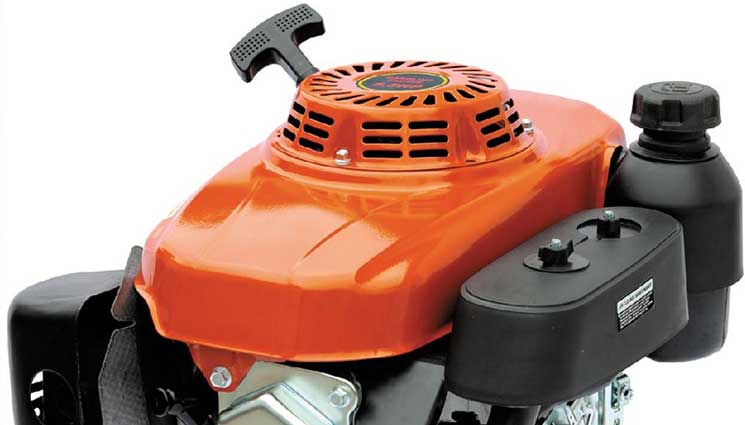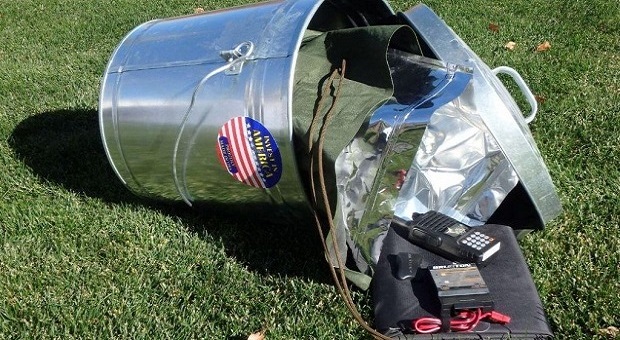
After the nuclear EMP was discovered in 1962 (US Starfish Prime Experiment) people have been searching for all kind of methods of protection (against electromagnetic pulses).
One of the solutions we came up with is storing important electronics in Faraday cages.
If you are not familiar with the destruction effects of an EMP, you should probably watch this short documentary and learn what the biggest threat to modern-day America is, and what you can do today to keep your family safe.
The Army is also preparing for this. Recently, NORAD has moved its communication equipment back to its nuclear Cold War-era bunker under the Cheyenne Mountain because this base is EMP hardened.
The government is also making small steps to harden the grid. Maine has become the first state in the nation to pass legislation ordering its grid to be hardened against an electromagnetic pulse.
Even the Police have some new small Faraday bags for confiscated cell phones – to preserve information.
Back in 2004, The Congressional Study EMP Report indicated potential casualty rates of 90%. Don’t expect Uncle Sam to protect you. We all have to be prepared.
To avoid a total collapse every American should have some EMP hardened equipment or at least a Faraday Cage to protect the most important survival electronics. (a radio, a small generator, electronic parts for cars, etc)
A Faraday cage is a sealed enclosure that has an electrically conductive outer layer and a non-conductive inner layer. The purpose of this box is to protect any electronics inside it in case of an EMP. I’ll also show you how to test your Faraday Cage (it’s easy).
Here are some Faraday Cages you can make at home in a couple of minutes:
1. From a Pasta – Fettuccine in this case – Box
8.5 inches high, 7.3 inches width and 3.3 inches deep
You can store in this box a small radio, a solar battery charger and some electronic parts (duplicates) for your car (like the PCM – Powertrain Control Module, the Anti-lock Braking System, the Electronic Fuel Injection, the Electronic Ignition, etc)
Wrap the box in heavy duty aluminum foil (at least two layers). When you do so… be careful to isolate it completely.

The Test: As you can see, I left a phone in it to test my Faraday cage. If you don’t wrap it completely in aluminum foil you’ll be able to call yourself from another phone. In this case, the box was perfect and I couldn’t call my phone because there was no signal in it. Anyway, the phone test is 99% accurate, because the phone signals are a bit higher in frequency than an EMP. If you want to be 100% sure that you made an EMP hardened Faraday cage then you should place a small turned on radio. If it stops… then you have an EMP hardened box.
Tip: if you can call your phone, then wrap the box in another layer of aluminum foil and try again.
2. From an Ammo Can
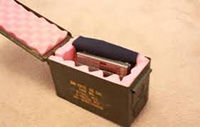
11 x 5.5 x 6.75 inches (volume – two times larger than the pasta box, but because you’ll lose some space with the inner non-conductive layer… the volume will be quite similar to the previous one – pasta box)
“This 50 Cal ammo can from an army surplus store and some scrap foam for padding and insulation make an inexpensive, easy to carry means of protecting essential electronics gear.”
3. From a Cardboard Box (from IKEA in this case)
8 inches high, 11 inches width and 13.3 inches deep (triple the volume of the Ammo can and 6 times larger than the pasta box)

The principle is the same (as Pasta box)… just that this one is larger and can be opened every time you want without tearing up the foil.
4. A Bird Cage
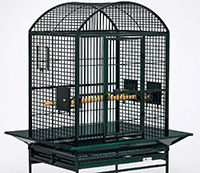
Volume: Variable – depending on the cages.
There are two problems with these cages:
- some have the bottom made of plastic (without any metal outer layer)
- and some have too large holes to protect against high frequencies
But chances are that you have a normal bird cage, which will work as a Faraday cage if you place some foam (for example) in it.
If it does not work, it probably means that the holes are too big so you’ll have to wrap the cage in aluminium.
5. From a Trash Can
20.5 x 20.5 x 27 inches (31 Gallon) – 6 times larger than the cardboard box

Line the trash can with cardboard (or carpet padding), including the bottom, making sure there are no gaps.
You can fit here a lot more electronics including an old laptop with your survival books and maybe a very small generator or a small solar panel.
6. An Old Wooden Ammo Box Wrapped in Aluminum Foil
Volume: Variable – depending on the boxes.

Similar to the cardboard box, but you have to pay attention to the nails.
You don’t want the nails (which the box already has) to connect the aluminum foil with the inside of the box.
7. A Metal Storage Cabinet
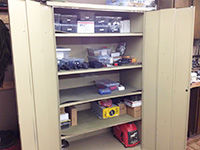
This Faraday cage provides greater storage capacity and extreme protection. It has a lot more space. I know someone who stores in it a small dorm size refrigerator.
Remember that everything you store in this Faraday cage has to be in a non-conductive box.
8. With Wood and Aluminum Screen
Volume – variable – depending on how big you want to make it.
There are many “walk in Faraday cages”… so if you want to build a huge one to store even a large generator or some solar panels, this is the method you should use.

Make a wooden frame and attach a wooden (frame) lid (using 1-2 hinges). Attach the screen mesh. Remember to isolate the bottom of the box (with wood, cardboard or plastic) and to keep away the electronics inside from the Aluminum Screen.
Tip: Instead of nailing the wood, try to glue it.
9. Using Cookie or Popcorn Tins

Volume: variable – depending on the tins.
The lids on these tins are typically very tight, which make them ideal Faraday cages.
Just line the inside with cardboard (including the lid) and put in the electronics you wish to protect from EMP’s.
If you find it too hard to line the inside of the box, then try this: put your phone (for the test) in an anti-static drive bag (plastic) and then put it in the tin.
10. Keeping the Generators/Tools/Radios/Electronics in Their Original Boxes
Volume: Variable – depending on the boxes.

This is the easiest way! Here is a video guide for this method. If you don’t use on a daily basis what you want to protect… just keep it in its original box and wrap it with heavy duty aluminum foil.
Some people may say that it’s crazy to prepare for an EMP. Well… I think that a solar storm is a real possibility. A terrorist EMP attack is also a real possibility. A nuclear war is also a real possibility. The probability: maybe 5% per year. But 5% is not crazy. Not even 1%. If your doctor says you have a 5% chance of dying … wouldn’t it be crazy not to do something about it?
Well… given the fact that it takes only 10 minutes (max. one hour) to build a Faraday cage, I consider this a well “invested” time.
On a national scale: It would be wise to follow Switzerland’s lead. According to Radasky, that country during the cold war hardened some of its critical infrastructure against EMPs, such as water works. “They felt that if there was high-altitude burst over Europe, they were going to be affected whether they were a combatant or not.”



















